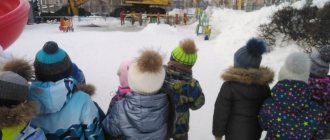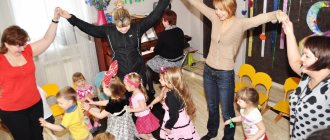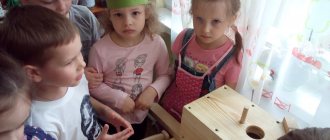Planning educational work for the week on the topic: “School”
PLANNING EDUCATIONAL WORK FOR THE WEEK
Topic: School Goal: To develop cognitive interest in school and books through role-playing games and artistic creativity. Consolidate children's knowledge about school, repeat and summarize information familiar to children about school (about who works at the school, what they teach there, about school supplies, about the importance of books).
| Day of the week | Mode | Integration of educational areas | Joint activities of adults and children, taking into account the integration of educational areas | Organization of a developmental environment for children’s independent activities (activity centers, all group rooms) | ||
| Group, subgroup | Individual | Educational activities in special moments | ||||
| 1 | 2 | 3 | 4 | 5 | 6 | 7 |
| Monday | Morning | Physical Culture; health, cognition, socialization | Morning exercises ; Examination of plot pictures: “Children at school”; Conversation : “April 2 – World Children’s Book Day” Goal: to develop interest in books | Memorizing Sergei Yesenin’s poem “Bird cherry” Didactic game : “Number houses” Goal: consolidating knowledge of the composition of numbers | A conversation about the benefits and properties of water when washing. Contents of the conversation: Man is made of water; Water is necessary for life, for hygiene, it is transparent, has no shape, color, or taste. | Attributes for story games : diaries, magazines, alphabet, pointer, notebooks, pens, pencils. |
| Direct educational activities | Fiction; socialization; health | 1. Music - according to the plan of the music director 2. Cognition (REMP) - “Quantitative and ordinal counting.” Goals and objectives: to develop general ideas about sets: the ability to form sets on given grounds, to see the components of a set in which objects differ in certain characteristics; consolidate children's knowledge of counting and counting objects; improve the skills of quantitative and ordinal counting within 20. 3. Communication - “Compiling a story based on a series of plot pictures “SCHOOL”. Goals and objectives: Improve the ability to write stories on a given topic based on a set of pictures with sequentially developing action; help draw up a story plan and stick to it; develop the ability to use complex sentences in speech; development of coherent speech; cultivate interest in school. | ||||
| Walk | Physical Culture; work; cognition; communication Cognition; Fiction; health Artistic creativity; work; cognition; communication. Physical Culture; work; cognition. | Observation of the thaw. Purpose: to consolidate the idea of snow as a special state of water; develop the ability to identify the first signs of spring D/i: “When does this happen?” Outdoor game : “Lesson and recess” | Practice jumping on two legs while moving forward; Repeating forward and backward counting within 10; D/n: “Where is my home?” | Experimentation: "Snow and Ice." Water that has changed its state under the influence of temperature. Situational conversation about the fact that melt water is dirty; after a walk, you need to thoroughly wash your hands with soap to avoid infections. | Removable material : turntables, spatulas, scoops. Attributes for story games : steering wheels, cap, baton, traffic light. | |
| Work before bed | Reading poems, proverbs and sayings about the benefits of sleep. Canteen duty | |||||
| Evening | Relaxation after sleep. Listening to music by P.I. Tchaikovsky "Snowdrop". Circle "Mastercraft" (according to the long-term plan). Making bookmarks for books and notebooks. | Work assignment : we seal up old books D/and according to REMP “Curve Mirrors” Purpose : to teach how to find the previous and sequential number | Situational conversation about caring for books as a source of knowledge. Talk about the importance of a book in a person’s life and what kinds of books there are. | Enriching the creativity corner with materials: sponges, paints, candles, wax crayons; Attributes for story games: card index, baby books, cards. | ||
| Walk | Watching kids coming home from school. Goal: to cultivate interest in school life among future first-graders; Labor: clearing paths on the site. P/I: “Lesson and recess”; “Runners” Independent activity: Games with external material (turntables) | |||||
Day of the week Mode Integration of educational areas Joint activities of adults and children, taking into account the integration of educational areas Organization of a developmental environment for children’s independent activities (activity centers, all group rooms) Group, subgroup Individual Educational activities at scheduled times 1 2 3 4 5 6 7 Tuesday Morning
Physical culture;
Health; cognition; socialization Morning exercises
;
Reading
Dragunsky's story "Childhood Friend."
Goal :
to cultivate a caring attitude towards toys and things dear to the heart.
D/I according to REMP:
“We defeated the Digitalosaurus.”
Goal:
to practice the ability to arrange numerical figures in ascending and descending order.
Situational conversation
about table manners.
(Beautiful behavior at the table shows our respect for other participants in the feast; straight posture, cleanliness and neatness) Board games:
“Mosaic”;
"Lacing"; "Lotto"; "Domino" Attributes for story games
: diaries, magazines, alphabet, pointer, notebooks, pens, pencils
Direct educational activities
Fiction;
health; cognition; communication. 1. Physical education
- according to the plan of the physical education instructor
2. Artistic creativity (modeling) - “Terem”.
Goals and objectives: to consolidate the methods of working in the “plasticineography” technique: rolling, flattening, making decorative elements;
encourage children to bring objects to be depicted in accordance with the theme and intent; develop children's creative imagination; develop the ability to create fabulous buildings, conveying the features of their structure and architecture, characteristic details. 3. Socialization, labor, safety.
– “Balcony, open window and other household hazards.” Goals and objectives: expand children's understanding of objects that can serve as sources of danger in the house.
Remind children that they cannot open the windows themselves and look out of them, or go out onto the balcony and play there. Continue to improve the dialogic and monologue form of speech. To develop the ability to conduct dialogue between the teacher and the child, between children; learn to be correct interlocutors. Walk
Cognition; Physical Culture; health; work; communication. Fiction; labor Health; work; cognition; communication; artistic creativity Cognition; Physical Culture; communication Surveillance
monitoring the movement of birds Goal: continue to consolidate children's knowledge about birds;
cultivate a caring attitude towards birds; encourage the desire to feed them. D/i:
“Flies or does not fly”
Outdoor game:
“Birds and nests”
Development of movements:
improve techniques for playing with a ball against the wall
Labor assignment:
Offer to collect dry branches on the site.
A conversation
about the beauty of nature and the harmony of nature and man.
Explain to the children how important it is to maintain order in the area, not to litter on the street, because people are part of nature. Remote materials:
turntables, savoki, spatulas.
Attributes for story games
: road signs, steering wheels, baton, cap.
Work before bed Reading
poems, proverbs and sayings about books.
Canteen
duty Evening Articulation gymnastics. Psychological living room.
(according to the psychologist’s plan)
Labor:
work on caring for plants, watering and loosening indoor plants.
D/I on cognition:
“Establish cause and effect”
Purpose:
to teach to establish cause and effect.
Memorizing
proverbs about learning
Situational conversation
about friendship.
Explain to the children. What is necessary is to treat peers with respect, look for common interests, help and help each other out, and not fight and swear. Enrichment of the creativity corner:
Salt dough;
illustrations of bakery products. Game corner:
various types of construction sets;
building models. Walk Observation
of passing vehicles.
P/N:
“Corners”;
“Empty space” D/I:
“Compliment the neighbor on the left”
Independent activity
: games with external material
Day of the week Mode Integration of educational areas Joint activities of adults and children, taking into account the integration of educational areas Organization of a developmental environment for independent activities of children (activity centers, all group rooms) Group, subgroup Individual Educational activities at scheduled moments 1 2 3 4 5 6 7 Wednesday
Morning
Physical culture;
Health; cognition; socialization Morning exercises. Conversation:
“School is coming!!!”
Goal:
to tell children about the features of school life: lessons, breaks, subjects studied, people working at school.
Graphic dictation
in mathematical notebooks
D/I:
“Decorate the word”
Situational conversation
about the need to acquire knowledge, since this is experience, experience accumulated over generations.
Learning proverbs
and
sayings
about knowledge and learning.
Enrichment of the creativity corner:
rulers, simple pencils, templates, sheets of paper.
Board games
"Adventure";
"Puzzles". Direct educational activities
Fiction;
communication; socialization; work; health 1. Music -
according to the music director's plan
2. Cognition (phenomena of social life) - “I have rights.”
Goals and objectives: to give children an idea of their rights and responsibilities;
develop self-esteem, awareness of your rights and freedoms; teach respect for the dignity and personal rights of others; talk about the norms and rules of behavior, ways of interacting with adults and peers. 3. Artistic creativity (drawing) - “The spring fly is in a hurry to visit us.”
Goals and objectives: learn to create an image of spring, depict its portrait, decoratively decorate the image;
teach to connect the poetic image of spring with the visual or folklore; consolidate knowledge about print painting; continue acquaintance with Russian folk traditions, expand knowledge about folklore; develop visual and auditory perception, figurative representation, thinking, imagination. Walk
Physical education; cognition; communication Fiction; labor Health; cognition; communication; Physical Culture; artistic creativity cognition; Physical Culture; communication Surveillance
behind the puddles.
Goal
: to form ideas about spring changes in inanimate nature;
cultivate a culture of behavior D/i:
“Guess what’s in the bag”
Outdoor game:
“Who’s quickest to the flag?”;
“Auntie Owl” Throwing a ball
at a target
Exercise
“I’m friends with a jump rope
Consolidating
ordinal counting
Situational conversation
about the benefits of physical exercise for human health;
Materials for experimentation:
bottles, water, salt, sugar, flour, butter.
Story games:
Ship, anchor, sea berets;
children's dishes. Work before bed Reading
the story “How Masha and Grisha set the table correctly and beautifully.”
Goal: by reading a story, convey to children information about how to properly set a festive table: you need to use a tablecloth, napkins, decorate the table with flowers and candles. Evening Finger gymnastics . “Fun Starts” Goal:
develop the ability to work in a team;
cultivate the will to win; D/I:
“We read funny poems and add a rhyme to the word”
Work assignment
to sharpen broken pencils;
D/I
“Clockwise and counterclockwise”
Experimenting
with cereals and water.
Goal: to consolidate knowledge about the properties of water; Show the children that cereals swell due to the absorption of water. Situational conversation
about the need to eat porridge in the morning, its benefits.
Enrichment of the creativity corner:
coloring books, pencils, felt-tip pens, wax crayons.
Walk Observing
the weather.
P/I:
“Lesson and recess”;
“Empty space” D/I:
“Run to the numbers”
Independent activity
: games with external material
Day of the week Mode Integration of educational areas Joint activities of adults and children, taking into account the integration of educational areas Organization of a developmental environment for children’s independent activities (activity centers, all group rooms) Group, subgroup Individual Educational activities at scheduled times 1 2 3 4 5 6 7 Thursday
Morning
Physical culture;
Health; cognition; socialization Morning exercises
;
Listening to
an audio recording of A.S. Pushkin’s fairy tale “The Tale of the Dead Princess and the Seven Knights”
D/I:
“Merry account”.
Goal:
to consolidate the agreement of numerals and nouns in speech
Drawing in the cells Work on the formation of cultural and hygienic skills
: cleaning
Reminder
of the need to wash your hands with soap.
If you wash your hands without soap. The bacteria will not disappear and can enter the human body with food. Enriching the corner of theatrical activities
with masks and caps.
For story games
: prepare a pointer, journal, alphabet, diaries, notebooks, pens, pencils, rulers.
Direct educational activities
Fiction;
health; socialization; artistic creativity 1. Physical education
- according to the plan of the physical education instructor
2. Cognition (REMP) - “Comparison of the lengths of two objects.”
Goals and objectives: learn to compare the length of two objects with the help of a third by superimposing;
correction of voluntary attention based on exercises in recognition and discrimination; learn to measure the length, width, height of objects using a conventional measure (checked paper); nurturing motivation to learn. 3. Communication – “Collective storytelling”:
Goals and objectives: develop the ability to compose stories from personal experience;
practice using complex sentences; in the agreement of adjectives and nouns in gender and case; learn to select words with the same root. Walk
Physical education; cognition; communication Music; labor Health; cognition; communication; artistic creativity; labor of knowledge; Physical Culture; communication Surveillance
behind the clouds
Goal:
to develop the ability to see the beauty of the sky, to develop imagination
D/i
: “Like - not like”;
“My cloud” Russian folk game :
“Ball up”
Practice
jumping rope;
Individual conversation
about the ability to keep negative emotions to oneself, not to take out evil on peers.
Work assignment
to collect large stones on the site
. Explain
to children that they should not interfere in the conversation of adults.
You need to be tactful, wait until the adults talk and only then ask your questions. Those children who interrupt adults violate the rules of etiquette. Takeaway materials
: turntables, spatulas, scoops.
Sports equipment:
jump ropes, ball, elastic band, skittles.
Work before bed Listening to
classical music P.I.
Tchaikovsky "Snowdrop". Relaxation. Canteen duty. Evening Articulatory gymnastics “Teaching literacy” (
according to long-term planning)
Role-playing game
“School”
Theatrical performance:
“Our emotions” Goal: to teach to recognize emotions by facial expressions
Work on teaching literacy:
Dividing two-syllable and three-syllable words into syllables
Labor assignment
to wash building material.
Praise
Dasha and Yaroslav for their help in washing the building material.
Remind
children why it is important to wash toys.
Board games:
“Puzzles”;
"Mosaic"; "Lacing"; "Lotto"; "Domino" Enrichment of the creativity corner:
dry and oil pastels;
candles; black and blue mascara, brushes, cotton swabs Walk Observe
the weather.
P/I:
“Stream”
D/I:
“Road Signs”
Independent activity
: games with external materials (turntables) and sports equipment (jump ropes, skittles)
Day of the week Mode Integration of educational areas Joint activities of adults and children, taking into account the integration of educational areas Organization of a developmental environment for children’s independent activities (activity centers, all group rooms) Group, subgroup Individual Educational activities at scheduled times 1 2 3 4 5 6 7 Friday
Morning
Physical culture;
health; cognition; socialization Morning exercises Conversation:
“What am I?”
Goal:
to teach children to comprehend and analyze their own actions;
develop the skill of reflection. Work assignment:
water indoor plants in a corner of nature.
REMP
.
Solving examples of addition and subtraction within 10. Situational conversation
about caring for toys and printed board games while sealing them.
Enrichment of the creativity corner:
napkins, stapler, double-sided tape, cardboard;
corrugated paper. Enriching the corner of theatrical activities:
puppet theater.
Direct educational activities
Communication;
cognition; health; fiction 1. Final event: Excursion to the library.
"International Children's Book Day." Goal: To introduce children to the city children's library;
tell about the fact that there is a holiday - World Children's Book Day; develop attention and thinking; cultivate interest in books, magazines, and interest in the library as a source of knowledge. 2. Physical education (on the street) - according to the plan of the physical education instructor Walk
Physical education; cognition; communication; labor labor; fiction; health health; cognition; communication; artistic creativity cognition; Physical Culture; communication Surveillance
behind tree branches.
Goal
: to consolidate knowledge that a tree is a living organism that needs water, light and heat, to learn to identify trees by external signs.
D/i :
“Finish the sentence”
Outdoor game :
“Bear and bees”
Labor assignment
to feed the birds.
REMP
forward and backward counting within 10.
Practice
jumping rope.
Situational conversation
about traffic rules during an excursion to the library.
Talk about traffic lights, pedestrian crossings, road signs. Removable material
: turntables, spatulas, scoops.
Sports equipment:
jump ropes, ball, elastic band, skittles.
Work before bed
Formation of cultural and hygienic skills: learn to dress and undress independently and quickly, put clothes in a closet, put shoes back in place, dry wet things if necessary.
Learning poems, proverbs and sayings about work. Evening Psychogymnastics.
Correction of negative behavior.
A game of attention and the ability to restrain oneself. Reading fiction.
S. Mikhalkov’s fable “Mistake”
Memorizing
Y. Akim’s poem “April”
Games for orientation in space Purpose:
to learn to place objects in the indicated direction, to reflect their spatial location in speech.
Conversation about health
during the arrival of a nurse.
Goal: to tell children about the need to monitor their health, exercise, and dress appropriately for the weather. Enrichment of the creativity corner:
colored paper, napkins, glue, cardboard, scissors.
Book corner:
exhibition design: “Our Favorite Writers” - books brought by children from home, magazines, postcards.
Walk Watching
the rain.
P/N:
“Stream”;
“Runners” D/I:
“Say the opposite”
Independent activity
: games with external materials (turntables) and sports equipment (jump ropes, skittles)


